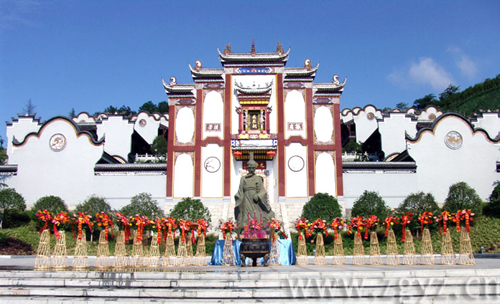Qu Yuan Temple
- Source: Hubei Provincial People's Government
- 09/06/2015 10:08
- 0 736

Originally built in 820 during the Tang Dynasty, the Qu Yuan Temple was built in remembrance of the great patriotic poet Qu Yuan who lived during the Warring States Period.
The temple was destroyed but restored during the Song, Yuan, Ming and Qing Dynasties. In 1978, the temple was moved to Xiangjiaping, which is 0.9 miles from Guizhou Town of Zigui County, due to the rising water level caused by the Gezhouba Water Conservancy Project.
The temple is in a courtyard style that is mainly composed of a gate, a main hall and a rear hall. The temple gate is a stele with four posts and 46 feet high. The main hall is in Ming and Qing architectural style and is grand. At the back of the main hall, there is the Qu Yuan Tomb. Although it is, only a cenotaph, the stone archway and some other things in front of the tomb are the relics of Qing Dynasty.
Also in the temple, there is a bronze statue of Qu Yuan, the stele corridor, and the Qu Yuan memorial hall. Cultural relics excavated in Zigui as well as the story of Qu Yuan are exhibited and described on the two floors of the memorial hall. The stele corridor has an assembly of the famous poems in Qu Yuan’s handwriting.
Each year, when the traditional Dragon Boat Festival takes place, it is usual for the dragon boat race to be held on the Yangtze River along the Qu Yuan Temple section. After visiting the Qu Yuan Temple, the hometown of Qu Yuan near the Zugui City is also worth a visit.
As the water level rises by 512 feet due to the Three Gorges Dam Project, the Qu Yuan Temple gate has been partially submerged. In order to protect the temple, it is to be moved to a new location - Fenghuang Mountain (Mt. Phoenix) in Maoping Town of Zigui that faces the Three Gorges Dam.